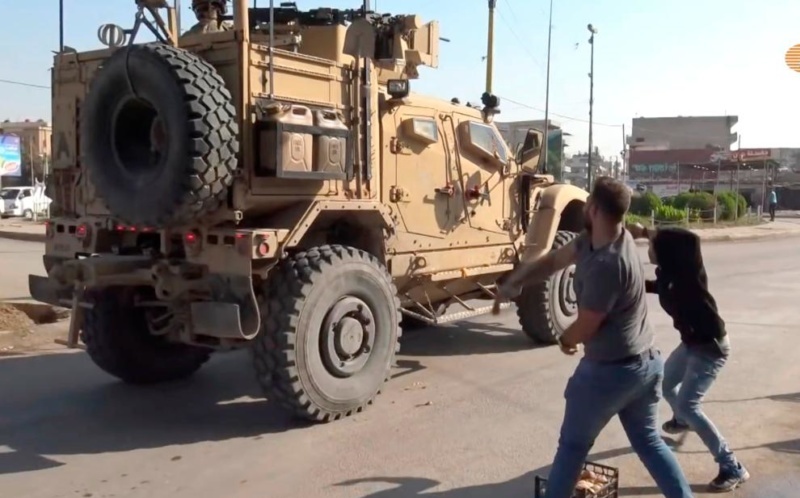Kurdish men throw stones at a US military vehicle as it leaves northeast Syria, October 21, 2019 (ANHA)
US troops hastened their withdrawal from Syria on Monday, amid the anger of local Kurds and confusion over the future status of American forces in the area.
More than 100 vehicles crossed into Iraq on Monday. The departure of the 1,000 soldiers — including 500 that were alongside the Kurdish-led Syrian Democratic Forces, created to push the Islamic State from the northeast of the country — was marked by the US destroying its weapons, equipment, and facilities, to avoid forces such as the Iranians and Russians from taking them.
Video showed Kurdish residents, furious at a perceived betrayal by the Americans, berating a convoy as youth pelted the US troops with stone and rotten fruit.
On October 6 Donald Trump made the impulsive decision, during a phone call with Turkish President Recep Tayyip Erdoğan, to withdraw the American forces. Three days later, Turkey and Syrian rebels launched an offensive to occupy a 480 km (270 mile) long and 30 km (19 mile) deep area along the Turkish-Syrian border, across the Kurdish cantons of Kobani and Cezire.
Ilhan Ahmed, in Washington to appeal to US legislators, called on Trump to reverse the order: “They want to attack us. They want to kill hundreds of thousands of us.”
Pentagon: We May Keep Some Troops in Syria
Trump showed no sign of shifting after his Sunday tweet in which he incorrectly named Defense Secretary Mark Esper (“Esperanto”) and falsely said US troops were coming home.
Meanwhile, there was confusion and signs of a Pentagon pushback to keep about 200 troops in northeast Syria.
Esper had said that US personnel would redeploy to western Iraq, but he told reporters on Monday that a force would remain in Syria to protect SDF-held oilfields: “The purpose is to deny access, specifically revenue to ISIS (Islamic State) and any other groups that may want to seek that revenue to enable their own malign activities.”
He did not mention that, in practice, Kurdish control of the oilfields will not be challenged by ISIS, which no longer has an organized presence in the northeast. Instead, the SDF are likely to be challenged by the Russian-backed Assad regime, which has said that it will regain the oil to counter a 75% fall in GDP during the 103-month conflict.
And the Defense Secretary, on a visit to Afghanistan, then muddled his statement by saying that retention of troops in Syria was only one option and no decision had been made “with regard to numbers or anything like that”.
He then said the Pentagon’s task is to look at “different options”.
The New York Times reported late Sunday, from unnamed sources, that the Trump Administration was leaning towards a plan to keep the 200 troops in northeast Syria. The White House did not comment on the article.
At a Cabinet meeting on Monday, Trump declared, “I’m the one that did the capturing” of ISIS and said, “We never agreed to protect the Kurds for the rest of their lives.” He then gave a muddled statement about the oilfields:
We want to keep the oil, and we’ll work something out with the Kurds so that they have some money, have some cashflow. Maybe we’ll have one of our big oil companies to go in and do it properly.
Meanwhile Trump — contradicting his agencies — again endorsed the Turkish-rebel offensive, saying that there would not have been an “easy deal” between the US and Ankara if the Kurds had not suffered from heavy attacks over a “couple of days”.
In December, Trump — again during a call with Erdoğan — ordered the withdrawal of the US personnel from Syria. Over the following weeks, the Pentagon and other US agencies chipped away at the decision to keep 1,000 troops in position, half alongside the SDF and half at the American base at Tanf in eastern Syria near the Iraq border.
Last Thursday, Turkey obtained US agreement to an ultimatum for the Kurdish militia YPG to leave the Ankara-declared “safe zone” along the border, extending east across the Euphrates River to Iraq. A five-day pause in military operations was declared.
The SDF left the border town of Ras al-Ain, but Erdoğan said that the offensive will resume if there is no full departure from the area.
The Turkish President meets Russian counterpart Vladimir Putin in Sochi in southern Russia on Tuesday.

